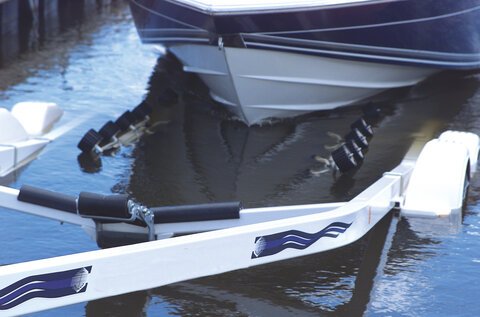Although your boat will spend about 95% of its life on a trailer, the trailer is one of the most neglected aspects of the boating equation—not a good thing.
A Tale of Two Trailers
A boat trailer’s job is to support the boat’s hull, while providing a stable, secure transportation platform for your boat.
There are two types of boat trailers: bunk trailers and roller trailers.
Most bunk trailers use long boards covered with carpet (bunks) to support a boat. These trailers are sometimes called “drive on” trailers, because you can literally use the boat’s engine to push the boat onto the trailer at the boat ramp.
Roller trailers have several sets of rubber/plastic rollers, mounted on pivoting bases, to carry the weight of the boat. Roller trailers are great for launching and retrieving a boat from a steep boat ramp—the rollers allow the boat to move on and off the trailer with less effort than with a bunk style trailer—so you can crank the boat on the trailer with the winch, instead of powering the boat onto the trailer with the engine.
After several seasons, you’ll probably need to put new carpet on the bunks (bunk trailer), or replace some of the rollers (roller trailer).
Bearings & Lubrication
The tires on your boat trailer are mounted on rims. The rims bolt to spindles, and the spindles attach to the axle. Inside of the spindles are bearings that reduce the friction between the spindles and axle.
The bearings require lubrication to prevent them from overheating (and failing) from excess friction. Most trailer bearings use waterproof grease as a lubricant; high-end trailers may use a thick oil to keep the bearings lubricated.
Either way, it’s very important to make sure the bearings have plenty of lubricant in them every time you take your boat to the launch ramp.
Grease lubricated bearings often have a small fitting in the center of the spindle. Using a grease gun on the fitting, pump fresh grease in the bearings until they’re full.
Oil lubricated bearings have a sight glass on the end of the spindle (rather than a grease fitting), allowing you to check the oil visually—without all the mess of a grease gun.
Trailer Lights
We don’t know any boaters who haven’t had problems with their trailer lights at some time or another.
A boat trailer’s light system isn’t complicated: a couple of lights on the rear, maybe some marker lights on the sides—all connected together with wires that run from the front of the trailer to the back.
So why all the trailer light hassles?
When you back the trailer into the water, you use the brakes on the tow vehicle. Putting your foot on the brake pedal makes both the vehicle’s and the trailer’s brake lights come on. The light bulbs in the brake lights/tail lights get hot when they’re on—and often fail when the hot bulbs are immersed in the cold water.
To avoid this, make it a habit to unplug the trailer lights at the boat ramp. Just don’t forget to connect the lights to the tow vehicle before you hit the road.
The Easy Way Out
Troubleshooting trailer light issues can be an exercise in frustration. If your boat trailer is more than ten years old (+/-), we wouldn’t invest a lot of time working on the lights—we’d suggest installing a new light system, complete with lights and wiring.
A new light system isn’t expensive, and a lot less aggravating than trying to resurrect old, dying trailer lights.

